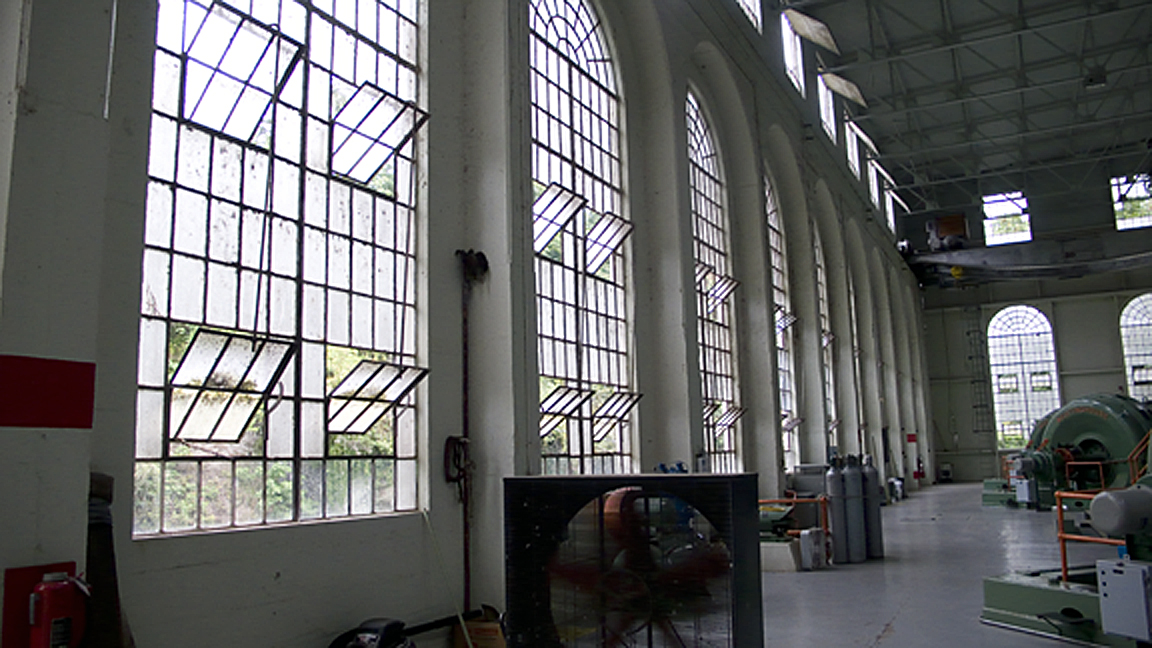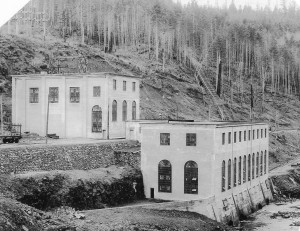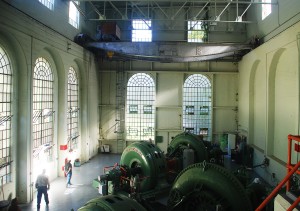We saw the Bull Run Powerhouse for the first time in 2008. Sitting on the Bull Run River northeast of Sandy, the generator room was roaring with four turbines generating 22 megawatts of electricity like it had since 1912. PGE was about to decommission the powerhouse by removing two dams that supplied its water. Due to Federal regulations, they had to offer this historic building for purchase to someone who would save and re-purpose it. So three crazy preservationists Rick Michaelson, Jeff Joslin and I jumped right in with all our hearts to save this special place for coming generations. Little did we know how hard it was going to be.

After three years of negotiations, on December 31, 2011 we became the proud and anxious owners of the Bull Run Powerhouse and 110 acres of land, including the closed Roslyn Lake Park and the Historic Bull Run Schoolhouse.
The difficult job was just beginning since these historic properties were located on land zoned Timber which severely restricted the uses that could occur there. We knew that to save these places they needed uses that could allow them to be economically viable. This would require a long and expensive process to change the zoning, including an amendment to Clackamas County’s Comprehensive Plan and a Goal Exception to move the land from Timber to Rural land.
We made our application to Clackamas County in November 2013, with the support of Restore Oregon. In March 2015, after four hearings before the Planning Commission and three before the Board of County Commissioners, we received approval for a limited number of uses at the Park, Schoolhouse and the Bull Run Powerhouse. Before we had time to celebrate, the zoning victory was appealed by neighbors to the Land Use Board of Appeals (LUBA).
 When we read the appeal we realized this was no longer just about our property, but had statewide consequences. The petitioners were challenging a core part of historic preservation, adaptive reuse. They argued that the requirements of Statewide Planning Goal 5, which governs historic resources, are fully met by local jurisdictions simply designating sites as historic and that there was no requirement to preserve historic resources.
When we read the appeal we realized this was no longer just about our property, but had statewide consequences. The petitioners were challenging a core part of historic preservation, adaptive reuse. They argued that the requirements of Statewide Planning Goal 5, which governs historic resources, are fully met by local jurisdictions simply designating sites as historic and that there was no requirement to preserve historic resources.
Further, the need to adaptively reuse a historic resource in order to produce sufficient income to maintain it could not be justification for a Goal Exception to allow a zone change. Without the goal exception that we needed, and the subsequent rezoning, these historic properties would face demolition-by-neglect.
We approached Restore Oregon and asked for their help. Steve Pfeiffer and Seth King, of Perkins Coie LLP, started working on our response to the appeal. However, since the appeal required deep knowledge of historic preservation, we asked Restore Oregon to intervene. Restore Oregon brought in Carrie Richter, of Garvey Schubert Barer PC who was assisted by Brandon Spencer Hartle, the Senior Field Programs Manager for Restore Oregon.
 The Restore Oregon brief strongly argued that the county has an obligation to support the conservation of historic resources and that without adaptive reuse these structures would effectively be demolished by neglect. LUBA agreed, thereby raising the status of historic preservation in the Oregon land use system.
The Restore Oregon brief strongly argued that the county has an obligation to support the conservation of historic resources and that without adaptive reuse these structures would effectively be demolished by neglect. LUBA agreed, thereby raising the status of historic preservation in the Oregon land use system.
We are grateful we have a statewide historic preservation organization that has the ability and willingness to intervene in matters of state-wide interest. Without Restore Oregon’s work we not only would have lost the Bull Run Powerhouse, but seen preservation’s role in Oregon considerably weakened. Thank you, Restore Oregon!
One Reply to “Saving the Powerhouse”
Comments are closed.


Thank you, Restore Oregon and Karen, Rick and Jeff, for fighting the good preservation fight, and sticking with this project to make a difference for all historic resources in Oregon. We and future Oregonians are lucky to have you on the job as preservation advocates.